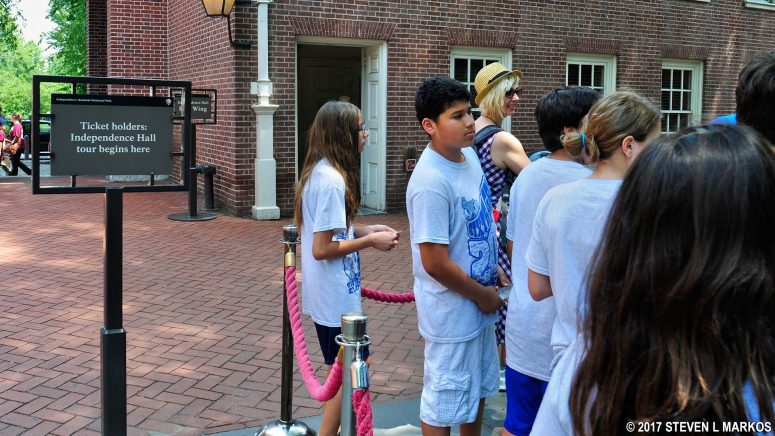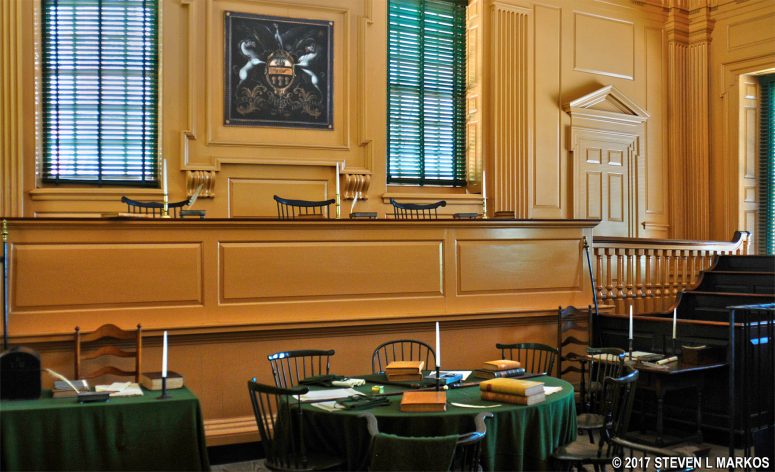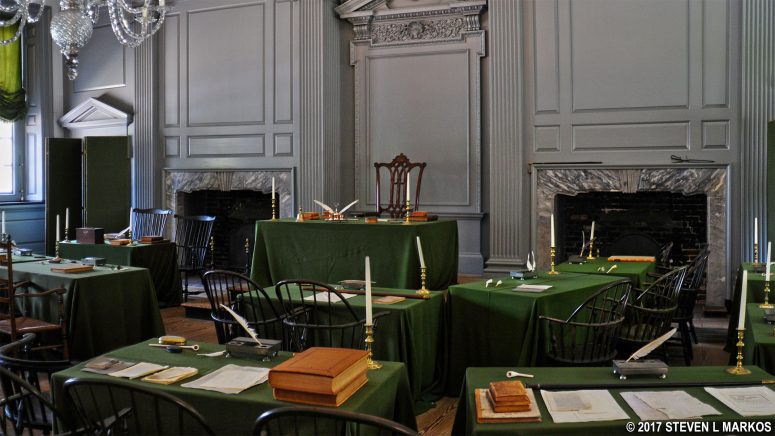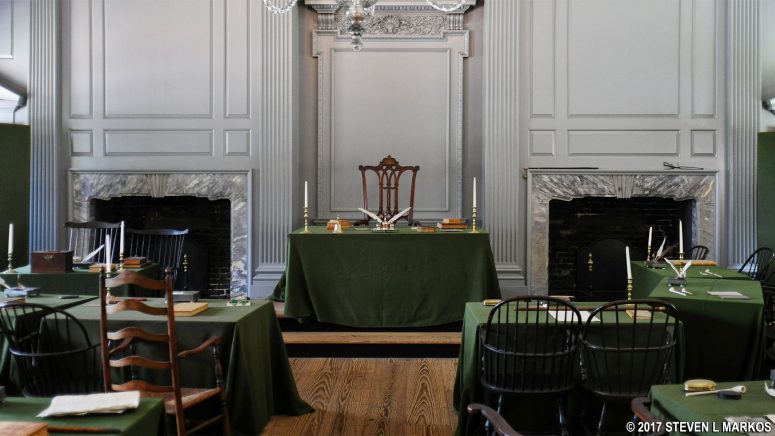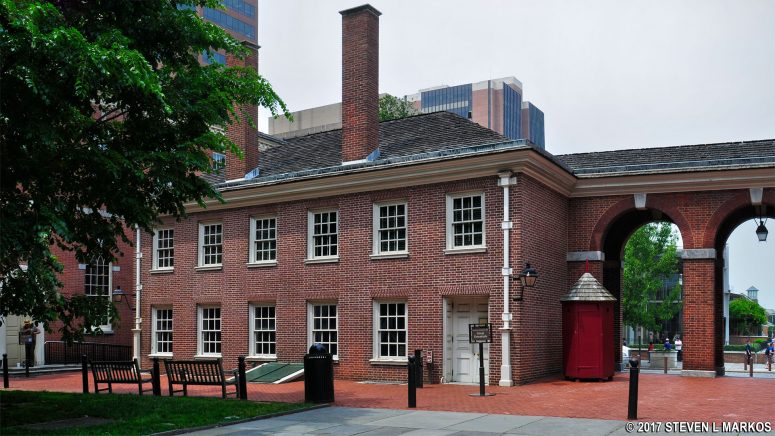SITE OVERVIEW
Independence Hall is a post-revolution name given to the Pennsylvania State House building. During its occupation by the second and third meetings of Congress between 1775 and 1787, independence from Great Britain was declared and the Declaration of Independence, the Articles of Confederation (the new government’s first constitution), and the current United States Constitution were all written and signed.
LOCATION
Independence Hall is located at 520 Chestnut Street (between 5th and 6th streets). In order to enter Independence Hall, all visitors must pass through an airport-type security gate located near the corner of 5th and Chestnut streets.
OPERATING HOURS
- Open daily
- Mid-June through Labor Day
- 9 AM to 7 PM
- All other days of the year
- 9 AM to 5 PM
- Closes at 8 PM on July 1 – 4
- Thanksgiving and New Year’s Day: 11 AM to 4 PM
- Christmas Eve: 9 AM to 3 PM
- Closed Christmas Day
Times can always change, so before making travel plans be sure to get the latest schedule on the National Park Service’s official Operating Hours and Seasons web page for Independence National Historical Park.
TICKETS AND FEES
A free ticket is required to tour Independence Hall from March through December between the hours of 9 AM and 5 PM. No tickets are needed in January and February; after 5 PM during the summer; or on Thanksgiving, Christmas Eve, and The Fourth of July. All tickets must be obtained online at Recreation.gov or by calling (877) 444-6777. Most tickets are available up to four months in advance, but a select number become available after 5 PM for the next day only. While technically free, there is a small service charge—$1 / ticket at the time of this writing. There are no refunds of the service charge if you do not make your tour for whatever reason, though you might be able to change tour times by calling Recreation.gov (phone number above).
Ticketed tours of Independence Hall depart every 20 minutes, with the first tour at 9 AM and the last tour at 4:40 PM. There are 60 tickets for each time slot.
The busiest time of year is May and June due to school groups, though July and August are also very busy. During these months tickets are usually “sold out” every day.
WHAT TO DO
Entry into Independence Hall is by Ranger-guided tour only. Tours begin outside the building; a sign marks the spot. When tickets are required, you must present either a printed ticket or be able to display your ticket order on a mobile device. When no tickets are required, you must wait in line. Rangers will let in a set number of people every 20 minutes.
For ticketed tours, it is recommended that you arrive at the security check point at least a half hour before your tour. There are other attractions inside the gated area (Congress Hall and The Great Essentials) that do not require a ticket, so there are things to do if you arrive even earlier.
Once it is time to begin, a Ranger will lead the group into the East Wing and will give a short lecture on the building’s history before proceeding into Independence Hall.
The first stop is the courtroom where the Pennsylvania Supreme Court met, both in colonial and post-colonial times. The room is furnished as it might have been in the mid-1780s.
On July 8, 1776, the Declaration of Independence was read to the public for the first time. Immediately afterwards, riled up patriots stormed the Pennsylvania State House and tore down the coat of arms of King George, then proceeded outside and burned it. Today the Pennsylvania coat of arms hangs over the judge’s bench. It was placed there in 1785.
The second stop on the tour is the Assembly Room where the Second Continental Congress and the Constitutional Congress met. While the interior of the building is mostly original, with only one exception, the furniture is not the same furniture that was in the building in the 1770s and 1780s. All of it is, however, Philadelphia made antiques from the same time period.
The only original furnishings are the Rising Sun Chair and the silver ink stand, which are featured at the center of the hall. The chair takes its name from the rising sun decoration engraved along the top of its back. This was used during the meeting of the Constitutional Congress in 1787, not during the earlier meeting of the Second Continental Congress. The ink stand is the one used during the signing of the Declaration of Independence.
The second floor is not shown during the busy season, but there are three rooms on that level: the Long Gallery, the Governor’s Council Chamber, and the Committee of the Assembly Chamber. To see these, take a tour in January or February. I visited in June when only the first floor is included on the tour.
Tours are on a tight schedule, and other groups are right behind you. The Rangers give short lectures about the importance of each room, answer a few questions, and then move on. If you have further questions, ask them outside after the tour is over. There are no exhibits in the building that require time to read.
SCHEDULING YOUR TIME
Allow one hour for your tour of Independence Hall. From the time I got in line at security until the time I was back outside was roughly 45 minutes, with perhaps a half hour spent inside the building.
INDEPENDENCE HALL HISTORY AND SIGNIFICANCE
The Pennsylvania State House, what is now known as Independence Hall, was where the Second Continental Congress met starting in May 1775 and remained throughout the American Revolution. However, the building itself was around long before that. Construction began in 1732 and was completed in 1753. It was built by the colony of Pennsylvania to be its capitol building. At the time, it was the largest building in the thirteen colonies.
Much of what you see today is a reconstruction. The east and west wings were torn down in 1812 and replaced with larger buildings to be used as government offices. During this time there was talk to tear down the entire Independence Hall, but local citizens banded together to halt the demolition. The city of Philadelphia then purchased the building from the state.
The wing replacements themselves were torn down in 1898 and reconstructions of the originals were built. This was the result of a public push to restore the building to its 1776 appearance.
The original steeple, which was made of wood, had rotted to the point that it was removed in 1781. The current steeple was erected in 1828.
Most of the interior was restored to its 1776 appearance by the National Park Service in the mid-1900s.
By the 1770s, Philadelphia was the largest city in America, which is why it was chosen as the meeting place for the colonial representatives, a group called the Continental Congress. The first meeting was held at Carpenters’ Hall from September 5 to October 26, 1774, to decide what to do about the escalating situation with Great Britain, particularly after the British enacted what the colonies called the Intolerable Acts. The decision was to petition King George with a list of grievances. The king’s response was to send more troops to the colonies in order to quell any talk of rebellion. This prompted the colonies to meet for a second time beginning in May 1775.
Now known as the Second Continental Congress, this time delegates met at the Pennsylvania State House. The Pennsylvania government moved to the upper level and gave the Congress use of the larger, lower level room. It is during the Second Continental Congress that independence from Great Britain was declared, the Declaration of Independence was adopted and signed, and the Articles of Confederation—the new country’s first constitution—was written.
Prior to the Articles of Confederation, Congress was called the Continental Congress. The Articles changed the name to the Confederation Congress, but all members still referred to themselves by the original name. Those elected to the Continental Congress automatically were members of the Confederation Congress; no new elections were required. Other than the name, there were very few changes to the way Congress operated.
Drawn up between 1776 and 1777 and ratified by the thirteen states in 1781, the Articles of Confederation had very limited power, with a major shortcoming being the inability to collect tax revenue. This was a big problem due to the debt the country had accumulated during the war. There was a growing desire for a stronger federal government and a revision of the Articles, so in 1787 it was decided that Congress would met for a third time starting on May 25th. Each state sent five delegates to what is now called the Constitutional Convention. The State House was chosen again as the meeting venue, though this time around the Pennsylvania government moved completely out and turned the entire building over to the Convention.
Though sent by their states to revise the Articles of Confederation, the delegates knew that the document was so weak and poorly written that this would be impossible. A completely new constitution was needed, though this was not authorized by the state governments. Thus, the delegates swore themselves to secrecy and set out to write a new constitution, which was signed on September 17, 1787.
Realizing that the state governments would never accept the new constitution because it had stripped away so much of their power, Congress called for each state to have a ratifying convention where the people elected the delegates. It also called for ratification by only nine of the thirteen states, whereas the Articles of Confederation had to be ratified unanimously. Within one year, eleven states had ratified the new constitution, making it the law of the land. In 1789, George Washington was elected the first president of the United States under the new constitution.
It is interesting to note that the United States technically existed once the Articles of Confederation were ratified on March 1, 1781, so there was a leader, or president, of the country on that date. This man was Samuel Johnston, the president of Congress. However, the first official election for a president wasn’t held until July 1781. Johnston was elected, but declined. This led to the election of Thomas McKean, but he only served three months of his one-year term. In November 1781, John Hanson was elected president and he finished his term, making him technically the first president of the United States to do so. Of course, history has long forgotten all of these men and instead remembers only George Washington.
With a few exceptions, use of any photograph on the National Park Planner website requires a paid Royalty Free Editorial Use License or Commercial Use License. See the Photo Usage page for details.
Last updated on August 6, 2022


